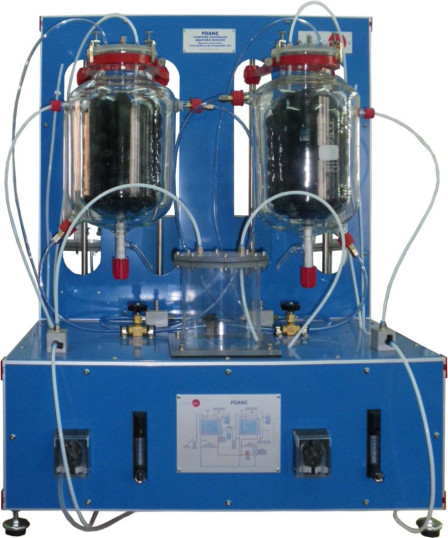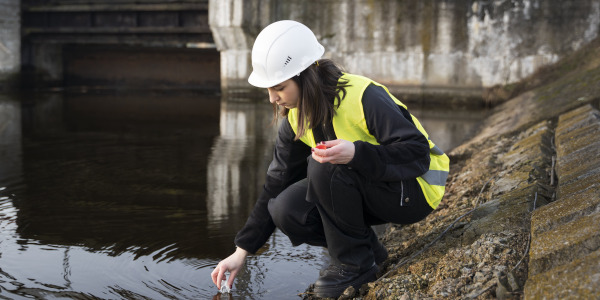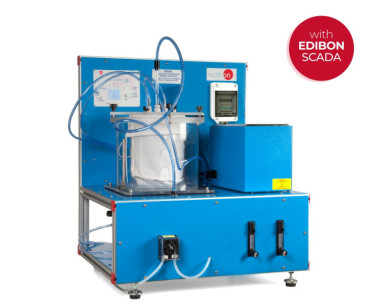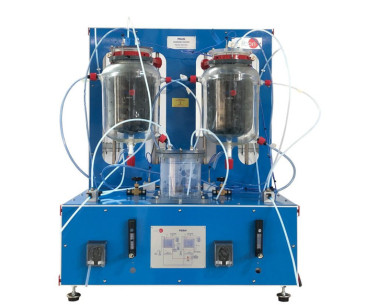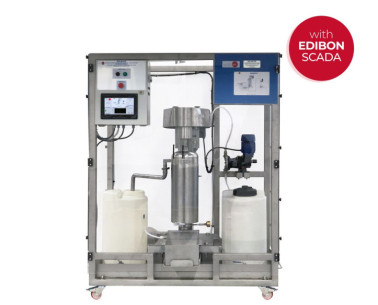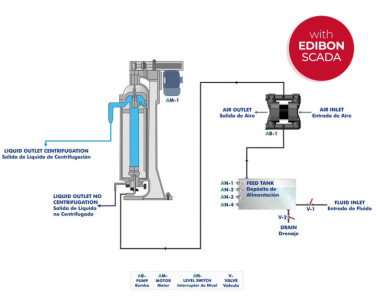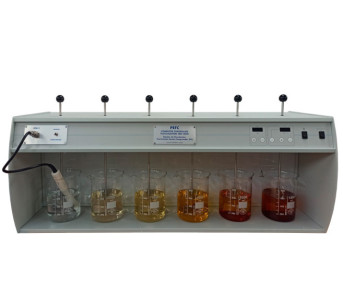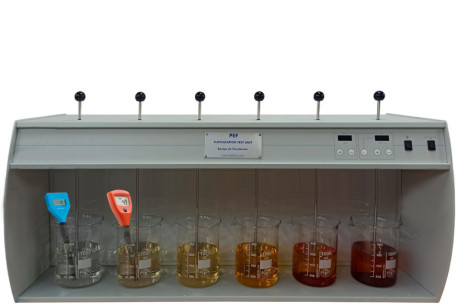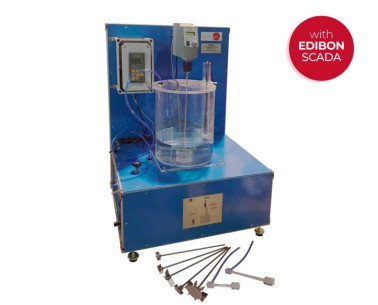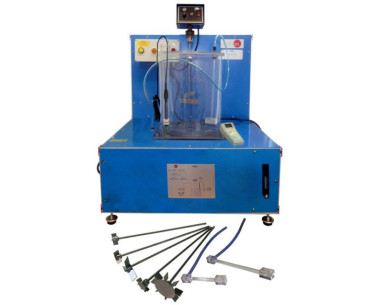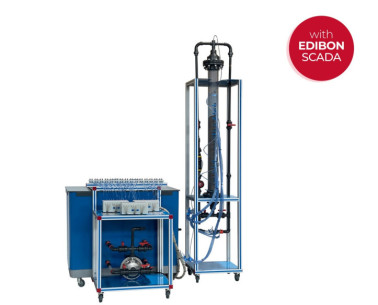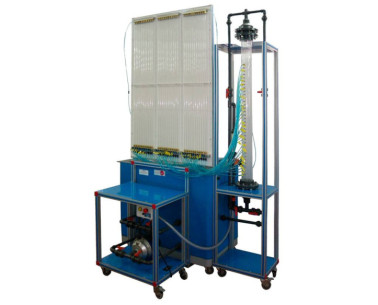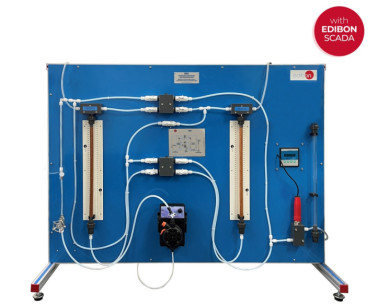PDANC Gerät für anaerobischen Reaktor, computergesteuert (PC)
INNOVATIVE SYSTEME
The objective of the Computer Controlled Anaerobic Digester, "PDANC", is to study and understand the stages of the anaerobic digestion, as well as the anaerobic digestion process itself. It is supplied with two packed anaerobic digesters. In this way, the user can work either in only one stage or in two stages, separating the different phases of the digestion process (the processes of hydrolysis, acidogenesis and acetogenesis would take place in the first digester, and the methanogenesis in the second digester).
Erweiterungen
Laboratorien
ÄHNLICHE NEUIGKEITEN
ALLGEMEINE BESCHREIBUNG
The objective of the Computer Controlled Anaerobic Digester, "PDANC", is to study and understand the stages of the anaerobic digestion, as well as the anaerobic digestion process itself. It is supplied with two packed anaerobic digesters. In this way, the user can work either in only one stage or in two stages, separating the different phases of the digestion process (the processes of hydrolysis, acidogenesis and acetogenesis would take place in the first digester, and the methanogenesis in the second digester).
Both digesters have a heating water circuit with valves to regulate the appropriate temperature in each part of the process and the operation with different ranges depending on the microorganisms used. Thus, it can operate at the psychrophilic range (room temperature), mesophilic range (temperatures around 35 °C) or thermophilic range (temperatures around 55 °C). The heating system of the digesters consists in making hot water from a computer controlled thermostatic bath flow through the jacket of the reactor.
The unit has two computer controlled peristaltic pumps to impel the supply to be introduced in the digesters. When working with a two-stage anaerobic digestion, one of the pumps carries the product from one of the digesters to the other, passing through a buffer tank, which collects the excess of flow from the first reactor. Two flowmeters measure the working flows.
Two volumetric tanks are also included for the storage and volume measurement of the generated biogas. The generated biogas flows through a pipe from the upper side of the digesters to these tanks, where the biogas volume is measured by means of a water displacement. Such tanks have two parts: the upper side is where the generated biogas is collected and the second part, smaller than the first one and located below it, is used to collect the displaced water.
Each digester has a temperature sensor and a pH sensor for the monitoring of the process and the study of the influence of the parameters that control the anaerobic digestion.
The unit is supplied with the suitable sensors and instrumentation for the most representative parameters measurements and controls.
This Computer Controlled Unit is supplied with the EDIBON Computer Control System (SCADA), and includes: The unit itself + a Control Interface Box + a Data Acquisition Board + Computer Control, Data Acquisition and Data Management Software Packages, for controlling the process and all parameters involved in the process.
ÜBUNGEN UND GEFÜHRTE PRAKTIKEN
GEFÜHRTE PRAKTISCHE ÜBUNGEN IM HANDBUCH ENTHALTEN
- Stabilization process study.
- Effect of temperature in the purification.
- Effect of the effluent pH in the digestion.
- Survey of the feeding rate in the purification.
- Study of the effluent strength.
- Study of the relation between the nutrient concentration in the effluent and purification.
- Study of the effect of the hydraulic charge in the purification.
- Study of the influence of the inhibitors to the anaerobic digestion.
- Comparison between mesophilic and thermophilic anaerobic digestion.
- Determination of the optimal working temperature.
- Determination of the optimal feeding rate.
- Determination of the optimal solids/water ratio.
- Determination of the optimal degradable/non-degradable solids ratio.
- Demonstration of the multistage nature of anaerobic digestion.
- Kinematics determination.
- Carbon balance.
- Solids Balance.
- Biogas Balance.
- Study of the effect of pH.
- Influent nutrient concentration.
- Preparation, warming and acclimation of an anaerobic reactor.
- Effluent treatability studies, including solids, carbon and biogas balances for determining the purification (COD-BOD).
- Study of the effects on purification performance of:
- Feed ratios.Hydraulic loading.
- Temperature.Influent strength.
- Nutrient deficiency.
- Sensors calibration.
MEHR PRAKTISCHE ÜBUNGEN FÜR DAS GERÄT
- Many students view results simultaneously. To view all results in real time in the classroom by means of a projector or an electronic whiteboard.
- Open Control, Multicontrol and Real Time Control. This unit allows intrinsically and/or extrinsically to change the span, gains, proportional, integral, derivative parameters, etc, in real time.
- The Computer Control System with SCADA and PID Control allow a real industrial simulation.
- This unit is totally safe as uses mechanical, electrical/electronic, and software safety devices.
- This unit can be used for doing applied research.
- This unit can be used for giving training courses to Industries even to other Technical Education Institutions.
- Control of the PDANC unit process through the control interface box without the computer.
- Visualization of all the sensors values used in the PDANC unit process.
- Several other exercises can be done and designed by the user.
ÄHNLICHE VERFÜGBARE GERÄTE
Gerät für aerobischen Reaktor
Gerät für anaerobischen Reaktor
ERGÄNZENDE AUSRÜSTUNG
Halbkontinuierlicher Zentrifugalseparator von 60 l, gesteuert vom Computer (PC) und Touchscreen
Halbkontinuierlicher Zentrifugalseparator von 1000 l, gesteuert vom Computer (PC) und Touchscreen
Gerät für aerobischen Reaktor, computergesteuert (PC)
Gerät für aerobischen Reaktor
Gerät für anaerobischen Reaktor
Gerät für Flockung, computergesteuert (PC)
Gerät für Flockung
Gerät zur Belüftung, computergesteuert (PC)
Gerät zur Belüftung
Gerät für Tiefenbettsfiltration, computergesteuert (PC)
Gerät für Tiefenbettsfiltration
Gerät für Ionenaustausch, computergesteuert (PC)
QUALITÄT

KUNDENDIENST

 Cookie-Präferenzen
Cookie-Präferenzen

